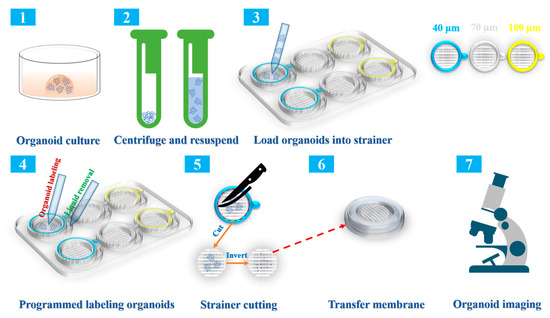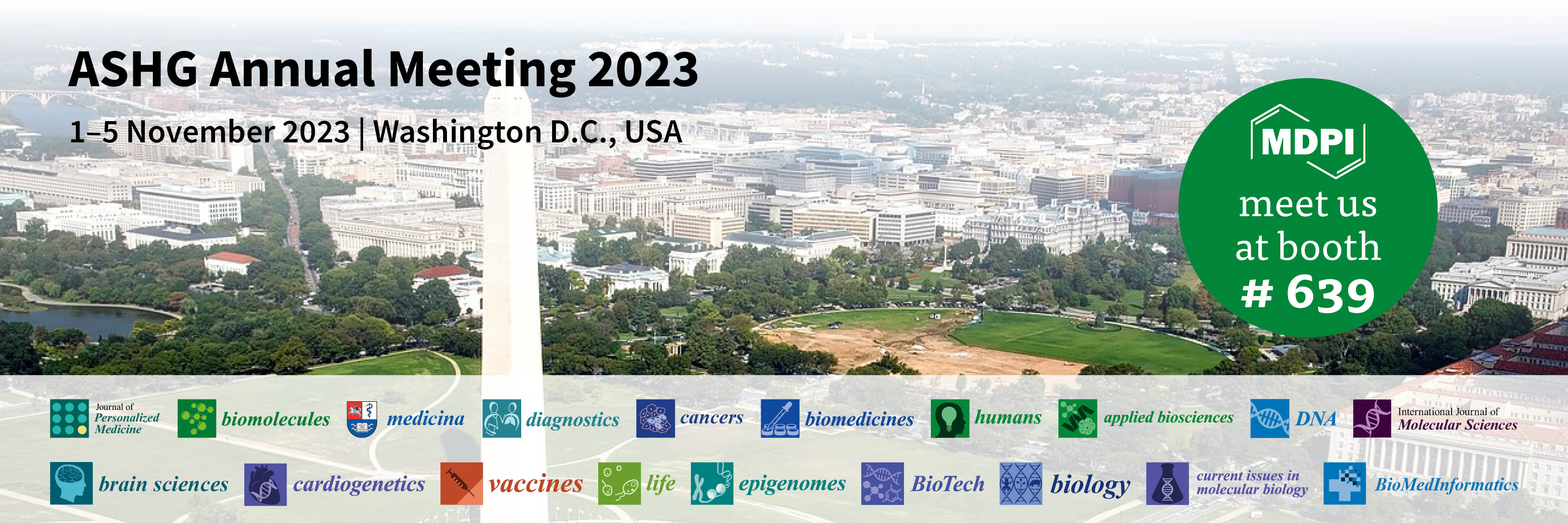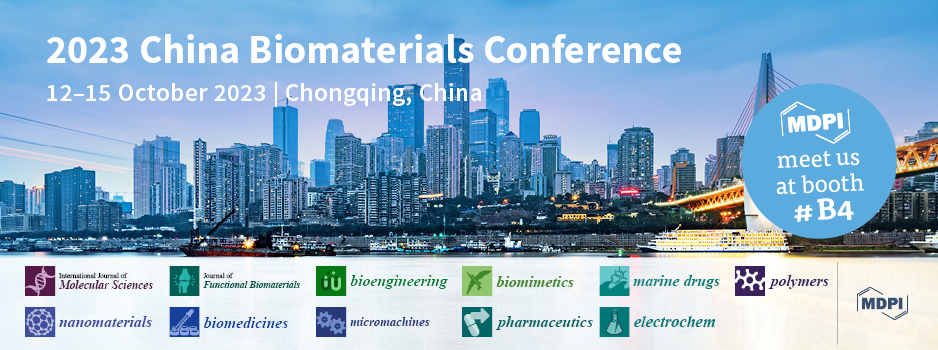-
 Tissue-Specific Hormone Signalling and Defence Gene Induction in an In Vitro Assembly of the Rapeseed Verticillium Pathosystem
Tissue-Specific Hormone Signalling and Defence Gene Induction in an In Vitro Assembly of the Rapeseed Verticillium Pathosystem -
 Adipose Tissue-Derived Mesenchymal Stem Cell-Derived Exosomes Promote Wound Healing and Tissue Regeneration
Adipose Tissue-Derived Mesenchymal Stem Cell-Derived Exosomes Promote Wound Healing and Tissue Regeneration -
 Triple-Isotope Tracing for Pathway Discernment of NMN-Induced NAD+ Biosynthesis in Whole Mice
Triple-Isotope Tracing for Pathway Discernment of NMN-Induced NAD+ Biosynthesis in Whole Mice
Journal Description
International Journal of Molecular Sciences
International Journal of Molecular Sciences
is an international, peer-reviewed, open access journal providing an advanced forum for biochemistry, molecular and cell biology, molecular biophysics, molecular medicine, and all aspects of molecular research in chemistry, and is published semimonthly online by MDPI. The Australian Society of Plant Scientists (ASPS), Epigenetics Society, European Calcium Society (ECS), European Chitin Society (EUCHIS), Spanish Society for Cell Biology (SEBC) and others are affiliated with IJMS and their members receive a discount on the article processing charges.
- Open Access— free for readers, with article processing charges (APC) paid by authors or their institutions.
- High Visibility: indexed within Scopus, SCIE (Web of Science), PubMed, PMC, MEDLINE, Embase, CAPlus / SciFinder, and other databases.
- Journal Rank: JCR - Q1 (Biochemistry & Molecular Biology) / CiteScore - Q1 (Inorganic Chemistry)
- Rapid Publication: manuscripts are peer-reviewed and a first decision is provided to authors approximately 16.8 days after submission; acceptance to publication is undertaken in 2.8 days (median values for papers published in this journal in the first half of 2023).
- Recognition of Reviewers: reviewers who provide timely, thorough peer-review reports receive vouchers entitling them to a discount on the APC of their next publication in any MDPI journal, in appreciation of the work done.
- Testimonials: See what our editors and authors say about the IJMS.
- Companion journals for IJMS include: Biophysica, Obesities, Stresses and Lymphatics.
Impact Factor:
5.6 (2022);
5-Year Impact Factor:
6.2 (2022)
Latest Articles
A Strainer-Based Platform for the Collection and Immunolabeling of Mouse Intestinal Organoids
Int. J. Mol. Sci. 2023, 24(17), 13568; https://doi.org/10.3390/ijms241713568 (registering DOI) - 01 Sep 2023
Abstract
Intestinal organoids have emerged as powerful model systems for studying the complex structure and function of the intestine. However, there is a lack of widely applicable methods for the collection, labeling, and imaging of intestinal organoids. In this study, we developed a novel
[...] Read more.
Intestinal organoids have emerged as powerful model systems for studying the complex structure and function of the intestine. However, there is a lack of widely applicable methods for the collection, labeling, and imaging of intestinal organoids. In this study, we developed a novel method for loading and labeling intestinal organoids, a method that efficiently collects the organoids and facilitates imaging of their three-dimensional (3D) structure. Based on this strainer platform, mouse intestinal organoids were adequately collected and immobilized, facilitating the immunolabeling workflow to target proteins of the organoids. After evaluation, the strainer size of 40 μm was considered to be more conducive to the collection and labeling of mouse intestinal organoids. More extensive research on organoids of multiple types and species origins will contribute to broadening the applicability of the methodology. Overall, our study proposes an innovative workflow for loading and analyzing intestinal organoids. The combination of a strainer-based collection method, fluorescent labeling, and 3D reconstruction provides valuable insights into the organization and complexity of these tissue models, thereby offering new avenues for investigating intestinal development, disease modeling, and drug discovery.
Full article
(This article belongs to the Special Issue Organoid Culture and Characterization Systems for Tissue Engineering Applications)
►
Show Figures
Open AccessArticle
Whole-Genome Sequencing Identified New Structural Variations in the DMD Gene That Cause Duchenne Muscular Dystrophy in Two Girls
by
, , , , , , , , and
Int. J. Mol. Sci. 2023, 24(17), 13567; https://doi.org/10.3390/ijms241713567 (registering DOI) - 01 Sep 2023
Abstract
Dystrophinopathies are the most common muscle diseases, especially in men. In women, on the other hand, a manifestation of Duchenne muscular dystrophy is rare due to X-chromosomal inheritance. We present two young girls with severe muscle weakness, muscular dystrophies, and creatine kinase (CK)
[...] Read more.
Dystrophinopathies are the most common muscle diseases, especially in men. In women, on the other hand, a manifestation of Duchenne muscular dystrophy is rare due to X-chromosomal inheritance. We present two young girls with severe muscle weakness, muscular dystrophies, and creatine kinase (CK) levels exceeding 10,000 U/L. In the skeletal muscle tissues, dystrophin staining reaction showed mosaicism. The almost entirely skewed X-inactivation in both cases supported the possibility of a dystrophinopathy. Despite standard molecular diagnostics (including multiplex ligation-dependent probe amplification (MLPA) and next generation sequencing (NGS) gene panel sequencing), the genetic cause of the girls’ conditions remained unknown. However, whole-genome sequencing revealed two reciprocal translocations between their X chromosomes and chromosome 5 and chromosome 19, respectively. In both cases, the breakpoints on the X chromosomes were located directly within the DMD gene (in introns 54 and 7, respectively) and were responsible for the patients’ phenotypes. Additional techniques such as Sanger sequencing, conventional karyotyping and fluorescence in situ hybridization (FISH) confirmed the disruption of DMD gene in both patients through translocations. These findings underscore the importance of accurate clinical data combined with histopathological analysis in pinpointing the suspected underlying genetic disorder. Moreover, our study illustrates the viability of whole-genome sequencing as a time-saving and highly effective method for identifying genetic factors responsible for complex genetic constellations in Duchenne muscular dystrophy (DMD).
Full article
(This article belongs to the Special Issue New Perspectives in Molecular Diagnosis of Neuromuscular Disorders)
►▼
Show Figures
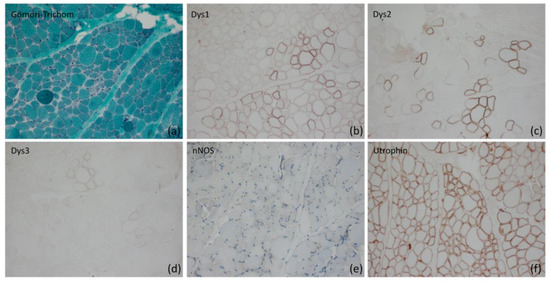
Figure 1
Open AccessReview
Nerve Structure-Function: Unusual Structural Details and Unmasking of Sulfhydryl Groups by Electrical Stimulation or Asphyxia in Axon Membranes and Gap Junctions
Int. J. Mol. Sci. 2023, 24(17), 13565; https://doi.org/10.3390/ijms241713565 (registering DOI) - 01 Sep 2023
Abstract
This review describes and discusses unusual axonal structural details and evidence for unmasking sulfhydryl groups (-SH) in axoplasmic membranes resulting from electrical stimulation or asphyxia. Crayfish axons contain fenestrated septa (FS) that, in phase contrast, micrographs appear as repeated striations. In the electron
[...] Read more.
This review describes and discusses unusual axonal structural details and evidence for unmasking sulfhydryl groups (-SH) in axoplasmic membranes resulting from electrical stimulation or asphyxia. Crayfish axons contain fenestrated septa (FS) that, in phase contrast, micrographs appear as repeated striations. In the electron microscope, each septum is made of two cross-sectioned membranes containing ~55 nm pores, each occupied by a microtubule. Thin filaments, which we believe are made of kinesin, bridge the microtubule to the edge of the pore. FS are believed to play a role in axoplasmic flow. The axons also display areas in which axon and sheath glial cell plasma membranes are sharply curved and project into the axoplasm. In freeze-fractures, the protoplasmic leaflet (P-face) of the projections appears as elongated indentations containing parallel chains of particles. The sheath glial cell plasma membrane also contains particles, but they are irregularly aggregated. The axons also display areas where axonal and glial plasma membranes fuse, creating intercellular pores. In axons fixed during electrical stimulation, the plasma membrane, the outer membrane of mitochondria, membranes of other cytoplasmic organelles, and gap junctions increase in electron opacity and thickness, resulting from unmasking of sulfhydryl groups (-SH). Similar changes occur in asphyxiated nerve cords.
Full article
(This article belongs to the Special Issue Molecular Advances in Nervous System Disorders)
►▼
Show Figures
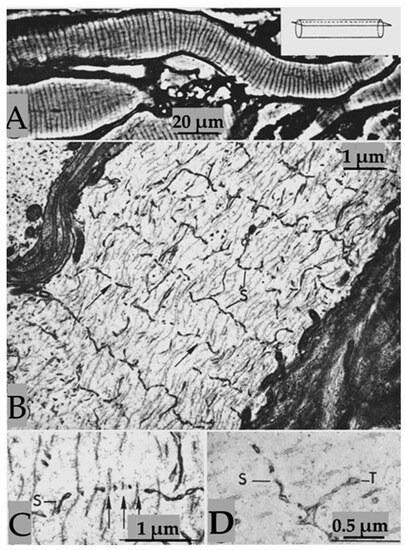
Figure 1
Open AccessReview
Long-Term Effects of ART on the Health of the Offspring
by
, , , , and
Int. J. Mol. Sci. 2023, 24(17), 13564; https://doi.org/10.3390/ijms241713564 (registering DOI) - 01 Sep 2023
Abstract
Assisted reproductive technologies (ART) significantly increase the chance of successful pregnancy and live birth in infertile couples. The different procedures for ART, including in vitro fertilization (IVF), intracytoplasmic sperm injection (ICSI), intrauterine insemination (IUI), and gamete intrafallopian tube transfer (GIFT), are widely used
[...] Read more.
Assisted reproductive technologies (ART) significantly increase the chance of successful pregnancy and live birth in infertile couples. The different procedures for ART, including in vitro fertilization (IVF), intracytoplasmic sperm injection (ICSI), intrauterine insemination (IUI), and gamete intrafallopian tube transfer (GIFT), are widely used to overcome infertility-related problems. In spite of its inarguable usefulness, concerns about the health consequences of ART-conceived babies have been raised. There are reports about the association of ART with birth defects and health complications, e.g., malignancies, high blood pressure, generalized vascular functional disorders, asthma and metabolic disorders in later life. It has been suggested that hormonal treatment of the mother, and the artificial environment during the manipulation of gametes and embryos may cause genomic and epigenetic alterations and subsequent complications in the health status of ART-conceived babies. In the current study, we aimed to review the possible long-term consequences of different ART procedures on the subsequent health status of ART-conceived offspring, considering the confounding factors that might account for/contribute to the long-term consequences.
Full article
(This article belongs to the Special Issue Reproductive Immunology: New Insights into Physiology and Pathophysiology of Pregnancy)
►▼
Show Figures
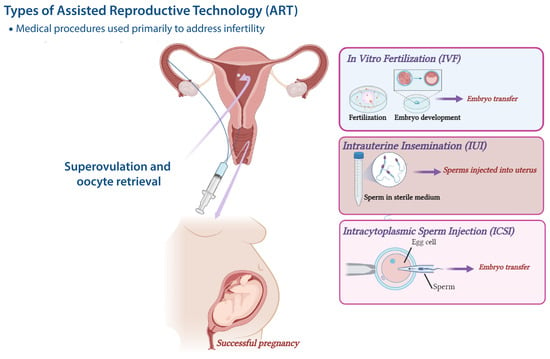
Figure 1
Open AccessArticle
Association of HDL Subfraction Profile with the Progression of Insulin Resistance
by
, , , , , , and
Int. J. Mol. Sci. 2023, 24(17), 13563; https://doi.org/10.3390/ijms241713563 (registering DOI) - 01 Sep 2023
Abstract
Type 2 diabetes mellitus (T2DM) is a major global public health problem, as it is associated with increased morbidity, mortality, and healthcare costs. Insulin resistance (IR) is a condition characterized by disturbances in carbohydrate and lipid metabolism that precedes T2DM. The aim of
[...] Read more.
Type 2 diabetes mellitus (T2DM) is a major global public health problem, as it is associated with increased morbidity, mortality, and healthcare costs. Insulin resistance (IR) is a condition characterized by disturbances in carbohydrate and lipid metabolism that precedes T2DM. The aim of the present study was to investigate the association between HDL and its subfraction profile and the progression of IR, as assessed by the Homeostatic Model Assessment for IR (HOMA-IR) index, and to define cut-off values to identify an increased risk of IR. Individuals with a HOMA-IR greater than 3.63 were considered to have IR. The HDL subfractions were separated using the Lipoprint system, which identifies ten subfractions (HDL-1-10) in three subclasses as large (HDL-L), intermediate (HDL-I) and small (HDL-S). Analyses were performed on samples from 240 individuals without IR and 137 with IR from the Hungarian general and Roma populations. The HDL-1 to -6 subfractions and the HDL-L and -I classes showed a significant negative association with the progression and existence of IR. Among them, HDL-2 (B = −40.37, p = 2.08 × 10−11) and HDL-L (B = −14.85, p = 9.52 × 10−10) showed the strongest correlation. The optimal threshold was found to be 0.264 mmol/L for HDL-L and 0.102 mmol/L and above for HDL-2. Individuals with HDL-L levels below the reference value had a 5.1-fold higher risk of IR (p = 2.2 × 10−7), while those with HDL-2 levels had a 4.2-fold higher risk (p = 3.0 × 10−6). This study demonstrates that the HDL subfraction profile (especially the decrease in HDL-2 and -L) may be a useful marker for the early detection and intervention of atherogenic dyslipidemia in subjects with impaired glucose and insulin metabolism.
Full article
(This article belongs to the Special Issue Obesity and Insulin Resistance: The Dark Sides of Adipose Organ Dysfunction in the Cardiometabolic Continuum)
►▼
Show Figures
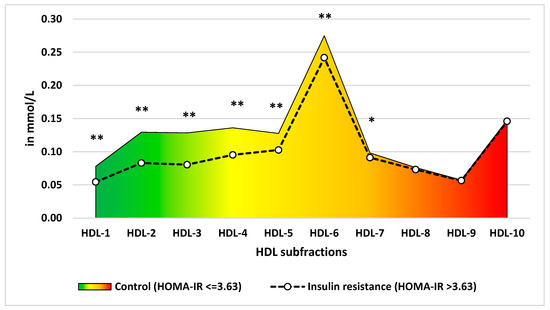
Figure 1
Open AccessArticle
Metabolomic Analysis of Pediatric Patients with Idiosyncratic Drug-Induced Liver Injury According to the Updated RUCAM
by
, , , and
Int. J. Mol. Sci. 2023, 24(17), 13562; https://doi.org/10.3390/ijms241713562 (registering DOI) - 01 Sep 2023
Abstract
Hepatotoxicity, a common adverse drug effect, has been extensively studied in adult patients. However, it is equally important to investigate this condition in pediatric patients to develop personalized treatment strategies for children. This study aimed to identify plasma biomarkers that characterize hepatotoxicity in
[...] Read more.
Hepatotoxicity, a common adverse drug effect, has been extensively studied in adult patients. However, it is equally important to investigate this condition in pediatric patients to develop personalized treatment strategies for children. This study aimed to identify plasma biomarkers that characterize hepatotoxicity in pediatric patients through an observational case–control study. Metabolomic analysis was conducted on 55 pediatric patients with xenobiotic liver toxicity and 88 healthy controls. The results revealed clear differences between the two groups. Several metabolites, including hydroxydecanoylcarnitine, octanoylcarnitine, lysophosphatidylcholine, glycocholic acid, and taurocholic acid, were identified as potential biomarkers (area under the curve: 0.817; 95% confidence interval: 0.696–0.913). Pathway analysis indicated involvement of primary bile acid biosynthesis and the metabolism of taurine and hypotaurine (p < 0.05). The findings from untargeted metabolomic analysis demonstrated an increase in bile acids in children with hepatotoxicity. The accumulation of cytotoxic bile acids should be further investigated to elucidate the role of these metabolites in drug-induced liver injury.
Full article
(This article belongs to the Special Issue Toxic Liver Injury: Molecular, Mechanistic, and Medical Challenges 2.0)
►▼
Show Figures
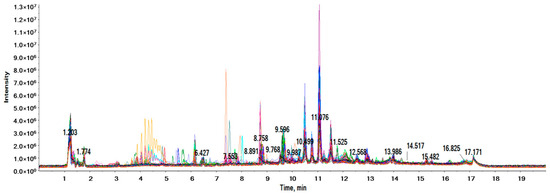
Figure 1
Open AccessBrief Report
Marine Bacterioplankton Community Dynamics and Potentially Pathogenic Bacteria in Seawater around Jeju Island, South Korea, via Metabarcoding
by
, , , , , , , and
Int. J. Mol. Sci. 2023, 24(17), 13561; https://doi.org/10.3390/ijms241713561 (registering DOI) - 01 Sep 2023
Abstract
Understanding marine bacterioplankton composition and distribution is necessary for improving predictions of ecosystem responses to environmental change. Here, we used 16S rRNA metabarcoding to investigate marine bacterioplankton diversity and identify potential pathogenic bacteria in seawater samples collected in March, May, September, and December
[...] Read more.
Understanding marine bacterioplankton composition and distribution is necessary for improving predictions of ecosystem responses to environmental change. Here, we used 16S rRNA metabarcoding to investigate marine bacterioplankton diversity and identify potential pathogenic bacteria in seawater samples collected in March, May, September, and December 2013 from two sites near Jeju Island, South Korea. We identified 1343 operational taxonomic units (OTUs) and observed that community diversity varied between months. Alpha- and Gamma-proteobacteria were the most abundant classes, and in all months, the predominant genera were Candidatus Pelagibacter, Leisingera, and Citromicrobium. The highest number of OTUs was observed in September, and Vibrio (7.80%), Pseudoalteromonas (6.53%), and Citromicrobium (6.16%) showed higher relative abundances or were detected only in this month. Water temperature and salinity significantly affected bacterial distribution, and these conditions, characteristic of September, were adverse for Aestuariibacter but favored Citromicrobium. Potentially pathogenic bacteria, among which Vibrio (28 OTUs) and Pseudoalteromonas (six OTUs) were the most abundant in September, were detected in 49 OTUs, and their abundances were significantly correlated with water temperature, increasing rapidly in September, the warmest month. These findings suggest that monthly temperature and salinity variations affect marine bacterioplankton diversity and potential pathogen abundance.
Full article
(This article belongs to the Special Issue Molecular World Today and Tomorrow: Recent Trends in Biological Sciences 2.0)
►▼
Show Figures
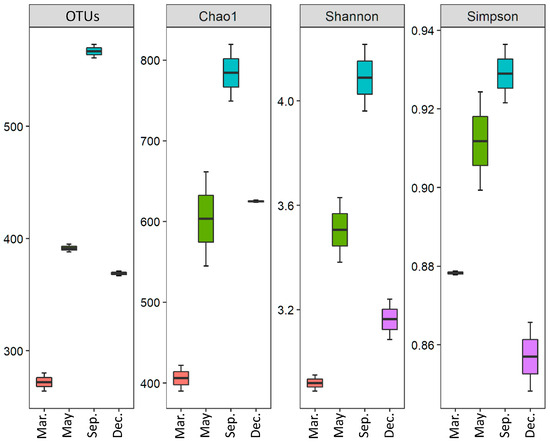
Figure 1
Open AccessArticle
Identification of a Non-Invasive Urinary Exosomal Biomarker for Diabetic Nephropathy Using Data-Independent Acquisition Proteomics
by
, , , , , , , , , , , and
Int. J. Mol. Sci. 2023, 24(17), 13560; https://doi.org/10.3390/ijms241713560 (registering DOI) - 01 Sep 2023
Abstract
Diabetic nephropathy (DN), as the one of most common complications of diabetes, is generally diagnosed based on a longstanding duration, albuminuria, and decreased kidney function. Some patients with the comorbidities of diabetes and other primary renal diseases have similar clinical features to DN,
[...] Read more.
Diabetic nephropathy (DN), as the one of most common complications of diabetes, is generally diagnosed based on a longstanding duration, albuminuria, and decreased kidney function. Some patients with the comorbidities of diabetes and other primary renal diseases have similar clinical features to DN, which is defined as non-diabetic renal disease (NDRD). It is necessary to distinguish between DN and NDRD, considering they differ in their pathological characteristics, treatment regimes, and prognosis. Renal biopsy provides a gold standard; however, it is difficult for this to be conducted in all patients. Therefore, it is necessary to discover non-invasive biomarkers that can distinguish between DN and NDRD. In this research, the urinary exosomes were isolated from the midstream morning urine based on ultracentrifugation combined with 0.22 μm membrane filtration. Data-independent acquisition-based quantitative proteomics were used to define the proteome profile of urinary exosomes from DN (n = 12) and NDRD (n = 15) patients diagnosed with renal biopsy and Type 2 diabetes mellitus (T2DM) patients without renal damage (n = 9), as well as healthy people (n = 12). In each sample, 3372 ± 722.1 proteins were identified on average. We isolated 371 urinary exosome proteins that were significantly and differentially expressed between DN and NDRD patients, and bioinformatic analysis revealed them to be mainly enriched in the immune and metabolic pathways. The use of least absolute shrinkage and selection operator (LASSO) logistic regression further identified phytanoyl-CoA dioxygenase domain containing 1 (PHYHD1) as the differential diagnostic biomarker, the efficacy of which was verified with another cohort including eight DN patients, five NDRD patients, seven T2DM patients, and nine healthy people. Additionally, a concentration above 1.203 μg/L was established for DN based on the ELISA method. Furthermore, of the 19 significantly different expressed urinary exosome proteins selected by using the protein–protein interaction network and LASSO logistic regression, 13 of them were significantly related to clinical indicators that could reflect the level of renal function and hyperglycemic management.
Full article
(This article belongs to the Section Molecular Endocrinology and Metabolism)
►▼
Show Figures
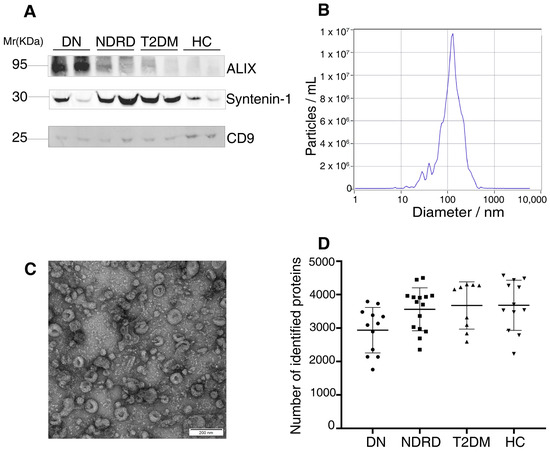
Figure 1
Open AccessArticle
Function of Transcription Factors PoMYB12, PoMYB15, and PoMYB20 in Heat Stress and Growth of Pleurotus ostreatus
Int. J. Mol. Sci. 2023, 24(17), 13559; https://doi.org/10.3390/ijms241713559 (registering DOI) - 31 Aug 2023
Abstract
MYB transcription factors (TFs) have been extensively studied in plant abiotic stress responses and growth and development. However, the role of MYB TFs in the heat stress response and growth and development of Pleurotus ostreatus remains unclear. To investigate the function of PoMYB12
[...] Read more.
MYB transcription factors (TFs) have been extensively studied in plant abiotic stress responses and growth and development. However, the role of MYB TFs in the heat stress response and growth and development of Pleurotus ostreatus remains unclear. To investigate the function of PoMYB12, PoMYB15, and PoMYB20 TFs in P. ostreatus, mutant strains of PoMYB12, PoMYB15, and PoMYB20 were generated using RNA interference (RNAi) and overexpression (OE) techniques. The results indicated that the mycelia of OE-PoMYB12, OE-PoMYB20, and RNAi-PoMYB15 mutant strains exhibited positive effects under heat stress at 32 °C, 36 °C, and 40 °C. Compared to wild-type strains, the OE-PoMYB12, OE-PoMYB20, and RNAi-PoMYB15 mutant strains promoted the growth and development of P. ostreatus. These mutant strains also facilitated the recovery of growth and development of P. ostreatus after 24 h of 36 °C heat stress. In conclusion, the expression of PoMYB12 and PoMYB20 supports the mycelium’s response to heat stress and enhances the growth and development of P. ostreatus, whereas PoMYB15 produces the opposite effect.
Full article
(This article belongs to the Section Molecular Microbiology)
►▼
Show Figures

Figure 1
Open AccessReview
The Therapeutic Potential of CDK4/6 Inhibitors, Novel Cancer Drugs, in Kidney Diseases
Int. J. Mol. Sci. 2023, 24(17), 13558; https://doi.org/10.3390/ijms241713558 (registering DOI) - 31 Aug 2023
Abstract
Inflammation is a crucial pathological feature in cancers and kidney diseases, playing a significant role in disease progression. Cyclin-dependent kinases CDK4 and CDK6 not only contribute to cell cycle progression but also participate in cell metabolism, immunogenicity and anti-tumor immune responses. Recently, CDK4/6
[...] Read more.
Inflammation is a crucial pathological feature in cancers and kidney diseases, playing a significant role in disease progression. Cyclin-dependent kinases CDK4 and CDK6 not only contribute to cell cycle progression but also participate in cell metabolism, immunogenicity and anti-tumor immune responses. Recently, CDK4/6 inhibitors have gained approval for investigational treatment of breast cancer and various other tumors. Kidney diseases and cancers commonly exhibit characteristic pathological features, such as the involvement of inflammatory cells and persistent chronic inflammation. Remarkably, CDK4/6 inhibitors have demonstrated impressive efficacy in treating non-cancerous conditions, including certain kidney diseases. Current studies have identified the renoprotective effect of CDK4/6 inhibitors, presenting a novel idea and potential direction for treating kidney diseases in the future. In this review, we briefly reviewed the cell cycle in mammals and the role of CDK4/6 in regulating it. We then provided an introduction to CDK4/6 inhibitors and their use in cancer treatment. Additionally, we emphasized the importance of these inhibitors in the treatment of kidney diseases. Collectively, growing evidence demonstrates that targeting CDK4 and CDK6 through CDK4/6 inhibitors might have therapeutic benefits in various cancers and kidney diseases and should be further explored in the future.
Full article
(This article belongs to the Special Issue Inflammation and Cancer 2023)
►▼
Show Figures
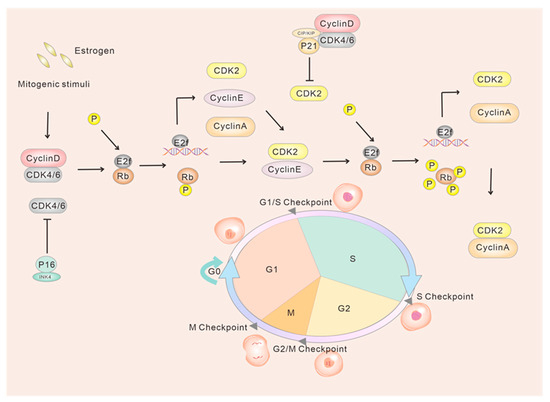
Figure 1
Open AccessArticle
Changes in Hemoglobin Properties in Complex with Glutathione and after Glutathionylation
by
, , , , , , , , and
Int. J. Mol. Sci. 2023, 24(17), 13557; https://doi.org/10.3390/ijms241713557 (registering DOI) - 31 Aug 2023
Abstract
Hemoglobin is the main protein of red blood cells that provides oxygen transport to all cells of the human body. The ability of hemoglobin to bind the main low-molecular-weight thiol of the cell glutathione, both covalently and noncovalently, is not only an important
[...] Read more.
Hemoglobin is the main protein of red blood cells that provides oxygen transport to all cells of the human body. The ability of hemoglobin to bind the main low-molecular-weight thiol of the cell glutathione, both covalently and noncovalently, is not only an important part of the antioxidant protection of red blood cells, but also affects its affinity for oxygen in both cases. In this study, the properties of oxyhemoglobin in complex with reduced glutathione (GSH) and properties of glutathionylated hemoglobin bound to glutathione via an SS bond were characterized. For this purpose, the methods of circular dichroism, Raman spectroscopy, infrared spectroscopy, tryptophan fluorescence, differential scanning fluorimetry, and molecular modeling were used. It was found that the glutathionylation of oxyhemoglobin caused changes in the secondary structure of the protein, reducing the alpha helicity, but did not affect the heme environment, tryptophan fluorescence, and the thermostability of the protein. In the noncovalent complex of oxyhemoglobin with reduced glutathione, the secondary structure of hemoglobin remained almost unchanged; however, changes in the heme environment and the microenvironment of tryptophans, as well as a decrease in the protein’s thermal stability, were observed. Thus, the formation of a noncovalent complex of hemoglobin with glutathione makes a more significant effect on the tertiary and quaternary structure of hemoglobin than glutathionylation, which mainly affects the secondary structure of the protein. The obtained data are important for understanding the functioning of glutathionylated hemoglobin, which is a marker of oxidative stress, and hemoglobin in complex with GSH, which appears to deposit GSH and release it during deoxygenation to increase the antioxidant protection of cells.
Full article
(This article belongs to the Special Issue Best Materials of the VII Congress of Russian Biophysicists)
►▼
Show Figures
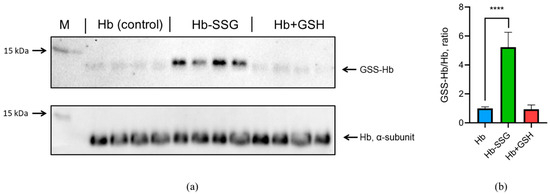
Figure 1
Open AccessArticle
Dynamic Changes in miRNA Expression during the Generation of Expanded and Activated NK Cells
Int. J. Mol. Sci. 2023, 24(17), 13556; https://doi.org/10.3390/ijms241713556 (registering DOI) - 31 Aug 2023
Abstract
Therapies based on allogenic Natural Killer (NK) cells are becoming increasingly relevant, and our laboratory has produced expanded and activated NK (eNK) cells that are highly cytotoxic against several hematological cancers when used alone or in combination with currently approved therapeutic monoclonal antibodies.
[...] Read more.
Therapies based on allogenic Natural Killer (NK) cells are becoming increasingly relevant, and our laboratory has produced expanded and activated NK (eNK) cells that are highly cytotoxic against several hematological cancers when used alone or in combination with currently approved therapeutic monoclonal antibodies. In order to produce eNK cells, healthy human donor NK cells undergo a 20-day expansion protocol with IL-2, IL-15 and Epstein–Barr virus (EBV)-transformed lymphoblastoid feeder cells. In order to produce an even more potent eNK-based therapy, we must elucidate the changes our protocol produces within healthy NK cells. To understand the post-transcriptional changes responsible for the increased cytolytic abilities of eNK cells, we performed microRNA (miRNA) expression analysis on purified NK cells from day 0 and day 20 of the protocol using quantitative reverse transcription PCR (RT-qPCR). Of the 384 miRNAs profiled, we observed changes in the expression of 64 miRNAs, with especially significant changes in 7 of them. The up-regulated miRNAs of note were miRs-146a, -124, -34a, and -10a, which are key in the regulation of cell survival through the modulation of pro-apoptotic genes such as PUMA. The down-regulation of miRs- 199a, -223, and -340 was also detected and is associated with the promotion of NK cell cytotoxicity. We validated our analysis using immunoblot and flow cytometry studies on specific downstream targets of both up- and down-regulated miRNAs such as PUMA and Granzyme B. These results corroborate the functional importance of the described miRNA expression patterns and show the wide variety of changes that occur in eNK cells at day 20.
Full article
(This article belongs to the Special Issue Epigenetics and Immunotherapy in Cancer)
Open AccessArticle
Tuning Molecular Orientation Responses of Microfluidic Liquid Crystal Dispersions to Colloid and Polymer Flows
by
and
Int. J. Mol. Sci. 2023, 24(17), 13555; https://doi.org/10.3390/ijms241713555 (registering DOI) - 31 Aug 2023
Abstract
An important approach to molecular diagnostics is integrating organized substances that provide complex molecular level responses to introduced chemical and biological agents with conditions that optimize and distinguish such responses. In this respect, liquid crystal dispersions are attractive components of molecular diagnostic tools.
[...] Read more.
An important approach to molecular diagnostics is integrating organized substances that provide complex molecular level responses to introduced chemical and biological agents with conditions that optimize and distinguish such responses. In this respect, liquid crystal dispersions are attractive components of molecular diagnostic tools. This paper analyzes a colloid system, containing a nematic liquid crystal as a dispersed phase, and aqueous surfactant and polymer solutions as the continuous phases. We applied a microfluidic approach for tuning orientation of liquid crystal molecules in picoliter droplets immobilized on microchannel walls. Introduction of surfactant to the aqueous phase was found to proportionally increase the order parameter of liquid crystal molecules in microdroplets. Infusion of polymer solutions into surfactant-mediated microfluidic liquid crystal dispersions increased the order parameter at much lower surfactant concentrations, while further infusion of surfactant solutions randomized the orientation of liquid crystal molecules. These effects were correlated with the adsorption of surfactant molecules on surfaces of microdroplets, stabilizing the effect of a polymer matrix on bound surfactant ions and the formation of insoluble polymer–colloid aggregates, respectively. The revealed molecular behavior of liquid crystal dispersions may contribute to optimized synthesis of responsive liquid crystal dispersions for in-flow molecular diagnostics of polymers and colloids, and the development of functional laboratory-on-chip prototypes.
Full article
(This article belongs to the Special Issue New Prospects of Colloid Chemistry – Molecular Perspectives)
►▼
Show Figures
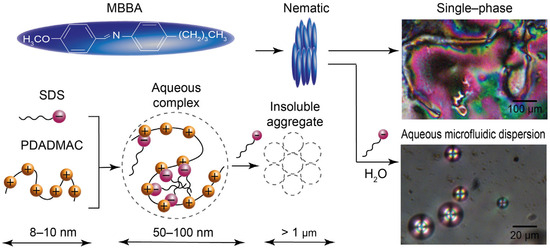
Figure 1
Open AccessArticle
Meta-Analysis of the Mechanisms Underlying COVID-19 Modulation of Parkinson’s Disease
Int. J. Mol. Sci. 2023, 24(17), 13554; https://doi.org/10.3390/ijms241713554 (registering DOI) - 31 Aug 2023
Abstract
Coronavirus disease-19 (COVID-19) is caused by the infection of severe acute respiratory syndrome-coronavirus-2 (SARS-CoV-2). The virus enters host cells through receptor-mediated endocytosis of angiotensin-converting enzyme-2 (ACE2), leading to systemic inflammation, also known as a “cytokine storm”, and neuroinflammation. COVID-19’s upstream regulator, interferon-gamma (IFNG),
[...] Read more.
Coronavirus disease-19 (COVID-19) is caused by the infection of severe acute respiratory syndrome-coronavirus-2 (SARS-CoV-2). The virus enters host cells through receptor-mediated endocytosis of angiotensin-converting enzyme-2 (ACE2), leading to systemic inflammation, also known as a “cytokine storm”, and neuroinflammation. COVID-19’s upstream regulator, interferon-gamma (IFNG), is downregulated upon the infection of SARS-CoV-2, which leads to the downregulation of ACE2. The neuroinflammation signaling pathway (NISP) can lead to neurodegenerative diseases, such as Parkinson’s disease (PD), which is characterized by the formation of Lewy bodies made primarily of the α-synuclein protein encoded by the synuclein alpha (SNCA) gene. We hypothesize that COVID-19 may modulate PD progression through neuroinflammation induced by cytokine storms. This study aimed to elucidate the possible mechanisms and signaling pathways involved in COVID-19-triggered pathology associated with neurodegenerative diseases like PD. This study presents the analysis of the pathways involved in the downregulation of ACE2 following SARS-CoV-2 infection and its effect on PD progression. Through QIAGEN’s Ingenuity Pathway Analysis (IPA), the study identified the NISP as a top-five canonical pathway/signaling pathway and SNCA as a top-five upstream regulator. Core Analysis was also conducted on the associated molecules between COVID-19 and SNCA to construct a network connectivity map. The Molecule Activity Predictor tool was used to simulate the infection of SARS-CoV-2 by downregulating IFNG, which leads to the predicted activation of SNCA, and subsequently PD, through a dataset of intermediary molecules. Downstream effect analysis was further used to quantify the downregulation of ACE2 on SNCA activation.
Full article
(This article belongs to the Special Issue Molecular Mechanisms of Pathogenesis, Prevention, and Therapy of COVID-19: Summarizing the Results of 2022)
►▼
Show Figures
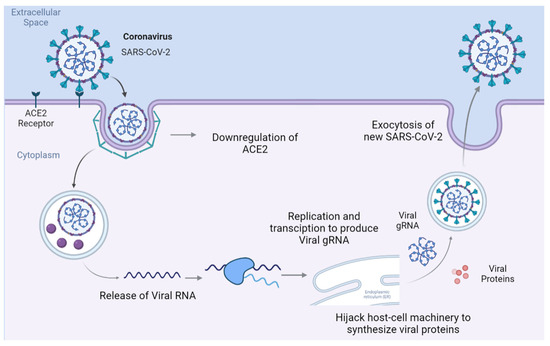
Figure 1
Open AccessArticle
Mechanism of Action and Efficiency of Ag3PO4-Based Photocatalysts for the Control of Hazardous Gram-Positive Pathogens
by
, , , , , , and
Int. J. Mol. Sci. 2023, 24(17), 13553; https://doi.org/10.3390/ijms241713553 (registering DOI) - 31 Aug 2023
Abstract
Silver phosphate and its composites have been attracting extensive interest as photocatalysts potentially effective against pathogenic microorganisms. The purpose of the present study was to investigate the mechanism of bactericidal action on cells of opportunistic pathogens. The Ag3PO4/P25 (AGP/P25)
[...] Read more.
Silver phosphate and its composites have been attracting extensive interest as photocatalysts potentially effective against pathogenic microorganisms. The purpose of the present study was to investigate the mechanism of bactericidal action on cells of opportunistic pathogens. The Ag3PO4/P25 (AGP/P25) and Ag3PO4/HA (HA/AGP) powders were prepared via a co-precipitation method. Thereafter, their antimicrobial properties against Enterococcus faecalis, Staphylococcus epidermidis, and Staphylococcus aureus (clinical and reference strains) were analyzed in the dark and after exposure to visible light (VIS). The mechanism leading to cell death was investigated by the leakage of metabolites and potassium ions, oxidative stress, and ROS production. Morphological changes of the bacterial cells were visualized by transmission electron microscopy (TEM) and scanning transmission electron microscopy with energy-dispersive X-ray spectroscopy (SEM EDS) analysis. It has been shown that Ag3PO4-based composites are highly effective agents that can eradicate 100% of bacterial populations during the 60 min photocatalytic inactivation. Their action is mainly due to the production of hydroxyl radicals and photogenerated holes which lead to oxidative stress in cells. The strong affinity to the bacterial cell wall, as well as the well-known biocidal properties of silver itself, increase undoubtedly the antimicrobial potential of the Ag3PO4-based composites.
Full article
(This article belongs to the Special Issue Innovative Approaches to Understand, Prevent and Eradicate Biofilms and Related Infections—a New Look from Natural Compounds to Nanotechnology)
►▼
Show Figures

Figure 1
Open AccessArticle
Multivessel Coronary Artery Disease Complicated by Diabetes Mellitus Has a Relatively Small Effect on Endothelial and Lipoprotein Lipases Expression in the Human Atrial Myocardium and Coronary Perivascular Adipose Tissue
by
, , , , , and
Int. J. Mol. Sci. 2023, 24(17), 13552; https://doi.org/10.3390/ijms241713552 (registering DOI) - 31 Aug 2023
Abstract
Endothelial (EL) and lipoprotein (LPL) lipases are enzymes involved in lipoproteins metabolism and formation of atherosclerosis, a pathological feature of coronary artery disease (CAD). This paper examines the role of the lipases in the right atrial appendage (RAA) and coronary perivascular adipose tissue
[...] Read more.
Endothelial (EL) and lipoprotein (LPL) lipases are enzymes involved in lipoproteins metabolism and formation of atherosclerosis, a pathological feature of coronary artery disease (CAD). This paper examines the role of the lipases in the right atrial appendage (RAA) and coronary perivascular adipose tissue (PVAT) of patients with CAD alone or with accompanying diabetes. Additionally, correlation analysis for plasma concentration of the lipases, apolipoproteins (ApoA-ApoJ) and blood lipids (Chol, HDL-C, LDL-C, TAG) was performed. We observed that CAD had little effect on the lipases gene/protein levels in the RAA, while their transcript content was elevated in the PVAT of diabetic CAD patients. Interestingly, the RAA was characterized by higher expression of EL/LPL (EL: +1-fold for mRNA, +5-fold for protein; LPL: +2.8-fold for mRNA, +12-fold for protein) compared to PVAT. Furthermore, ApoA1 plasma concentration was decreased, whereas ApoC1 and ApoH were increased in the patients with CAD and/or diabetes. The concentrations of ApoC3 and ApoD were strongly positively correlated with TAG content in the blood, and the same was true for ApoB with respect to LDL-C and total cholesterol. Although plasma concentrations of EL/LPL were elevated in the patients with diabetes, CAD alone had little effect on blood, myocardial and perivascular fat expression of the lipases.
Full article
(This article belongs to the Section Molecular Biology)
►▼
Show Figures
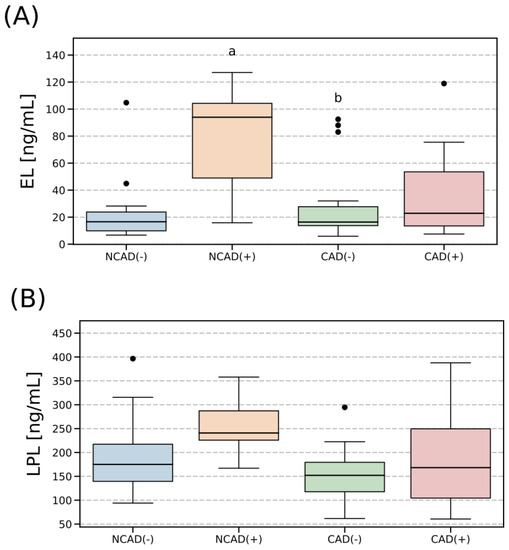
Figure 1
Open AccessArticle
Dual Adeno-Associated Virus 9 with Codon-Optimized DYSF Gene Promotes In Vivo Muscle Regeneration and May Decrease Inflammatory Response in Limb Girdle Muscular Dystrophy Type R2
by
, , , , , , , , , , , , , and
Int. J. Mol. Sci. 2023, 24(17), 13551; https://doi.org/10.3390/ijms241713551 (registering DOI) - 31 Aug 2023
Abstract
Dysferlinopathy treatment is an active area of investigation. Gene therapy is one potential approach. We studied muscle regeneration and inflammatory response after injection of an AAV-9 with a codon-optimized DYSF gene. A dual-vector system AAV.DYSF.OVERLAP with overlapping DYSF cDNA sequences was generated. Two
[...] Read more.
Dysferlinopathy treatment is an active area of investigation. Gene therapy is one potential approach. We studied muscle regeneration and inflammatory response after injection of an AAV-9 with a codon-optimized DYSF gene. A dual-vector system AAV.DYSF.OVERLAP with overlapping DYSF cDNA sequences was generated. Two AAV vectors were separately assembled by a standard triple-transfection protocol from plasmids carrying parts of the DYSF gene. Artificial myoblasts from dysferlin-deficient fibroblasts were obtained by MyoD overexpression. RT-PCR and Western blot were used for RNA and protein detection in vitro. A dysferlinopathy murine model (Bla/J) was used for in vivo studies. Histological assay, morphometry, and IHC were used for the muscle tissue analysis. Dysferlin was detected in vitro and in vivo at subphysiological levels. RT-PCR and Western Blot detected dysferlin mRNA and protein in AAV.DYSF.OVERLAP-transduced cells, and mRNA reached a 7-fold elevated level compared to the reference gene (GAPDH). In vivo, the experimental group showed intermediate median values for the proportion of necrotic muscle fibers, muscle fibers with internalized nuclei, and cross-sectional area of muscle fibers compared to the same parameters in the control groups of WT and Bla/J mice, although the differences were not statistically significant. The inverse relationship between the dosage and the severity of inflammatory changes in the muscles may be attributed to the decrease in the number of necrotic fibers. The share of transduced myofibers reached almost 35% in the group with the highest dose. The use of two-vector systems based on AAV is justified in terms of therapeutic efficacy. The expression of dysferlin at a subphysiological level, within a short observation period, is capable of inducing the restoration of muscle tissue structure, reducing inflammatory activity, and mitigating necrotic processes. Further research is needed to provide a more detailed assessment of the impact of the transgene and viral vector on the inflammatory component, including longer observation periods.
Full article
(This article belongs to the Special Issue Fundamental and Practical Perspectives in Regenerative Medicine: Proceedings of the V National Congress of Regenerative Medicine (2022))
►▼
Show Figures

Figure 1
Open AccessReview
Two Sides of The Same Coin: Normal and Tumoral Stem Cells, The Relevance of In Vitro Models and Therapeutic Approaches: The Experience with Zika Virus in Nervous System Development and Glioblastoma Treatment
by
, , , , , , , and
Int. J. Mol. Sci. 2023, 24(17), 13550; https://doi.org/10.3390/ijms241713550 (registering DOI) - 31 Aug 2023
Abstract
Neural stem cells (NSCs) were described for the first time more than two decades ago for their ability to differentiate into all neural cell lineages. The isolation of NSCs from adults and embryos was carried out by various laboratories and in different species,
[...] Read more.
Neural stem cells (NSCs) were described for the first time more than two decades ago for their ability to differentiate into all neural cell lineages. The isolation of NSCs from adults and embryos was carried out by various laboratories and in different species, from mice to humans. Similarly, no more than two decades ago, cancer stem cells were described. Cancer stem cells, previously identified in hematological malignancies, have now been isolated from several solid tumors (breast, brain, and gastrointestinal compartment). Though the origin of these cells is still unknown, there is a wide consensus about their role in tumor onset, propagation and, in particular, resistance to treatments. Normal and neoplastic neural stem cells share common characteristics, and can thus be considered as two sides of the same coin. This is particularly true in the case of the Zika virus (ZIKV), which has been described as an inhibitor of neural development by specifically targeting NSCs. This understanding prompted us and other groups to evaluate ZIKV action in glioblastoma stem cells (GSCs). The results indicate an oncolytic activity of this virus vs. GSCs, opening potentially new possibilities in glioblastoma treatment.
Full article
(This article belongs to the Special Issue Neural Stem Cells: Focusing on Disease Modeling and Translational Application)
►▼
Show Figures
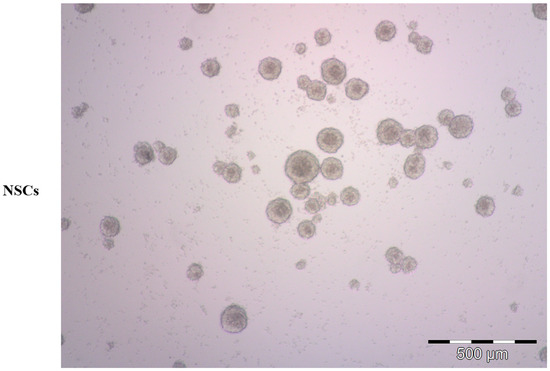
Figure 1
Open AccessArticle
Metallic Nanowires Self-Assembled in Quasi-Circular Nanomolds Templated by DNA Origami
Int. J. Mol. Sci. 2023, 24(17), 13549; https://doi.org/10.3390/ijms241713549 (registering DOI) - 31 Aug 2023
Abstract
The self-assembly of conducting nanostructures is currently being investigated intensively in order to evaluate the feasibility of creating novel nanoelectronic devices and circuits using such pathways. In particular, methods based on so-called DNA Origami nanostructures have shown great potential in the formation of
[...] Read more.
The self-assembly of conducting nanostructures is currently being investigated intensively in order to evaluate the feasibility of creating novel nanoelectronic devices and circuits using such pathways. In particular, methods based on so-called DNA Origami nanostructures have shown great potential in the formation of metallic nanowires. The main challenge of this method is the reproducible generation of very well-connected metallic nanostructures, which may be used as interconnects in future devices. Here, we use a novel design of nanowires with a quasi-circular cross-section as opposed to rectangular or uncontrolled cross-sections in earlier studies. We find indications that the reliability of the fabrication scheme is enhanced and the overall resistance of the wires is comparable to metallic nanostructures generated by electrochemistry or top-down methods. In addition, we observe that some of the nanowires are annealed when passing a current through them, which leads to a clear enhancement for the conductance. We envision that these nanowires provide further steps towards the successful generation of nanoelectronics using self-assembly.
Full article
(This article belongs to the Special Issue Future Perspectives in Nanostructured Materials Preparation, Characteristics and Applications)
►▼
Show Figures
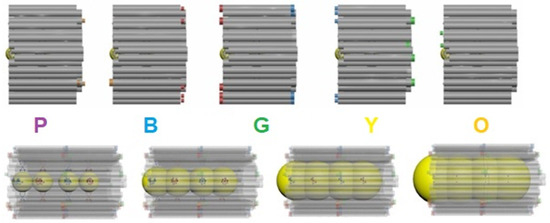
Figure 1
Open AccessArticle
Human Endocrine-Disrupting Effects of Phthalate Esters through Adverse Outcome Pathways: A Comprehensive Mechanism Analysis
Int. J. Mol. Sci. 2023, 24(17), 13548; https://doi.org/10.3390/ijms241713548 (registering DOI) - 31 Aug 2023
Abstract
Phthalate esters (PAEs) are widely exposed in the environment as plasticizers in plastics, and they have been found to cause significant environmental and health hazards, especially in terms of endocrine disruption in humans. In order to investigate the processes underlying the endocrine disruption
[...] Read more.
Phthalate esters (PAEs) are widely exposed in the environment as plasticizers in plastics, and they have been found to cause significant environmental and health hazards, especially in terms of endocrine disruption in humans. In order to investigate the processes underlying the endocrine disruption effects of PAEs, three machine learning techniques were used in this study to build an adverse outcome pathway (AOP) for those effects on people. According to the results of the three machine learning techniques, the random forest and XGBoost models performed well in terms of prediction. Subsequently, sensitivity analysis was conducted to identify the initial events, key events, and key features influencing the endocrine disruption effects of PAEs on humans. Key features, such as Mol.Wt, Q+, QH+, ELUMO, minHCsats, MEDC-33, and EG, were found to be closely related to the molecular structure. Therefore, a 3D-QSAR model for PAEs was constructed, and, based on the three-dimensional potential energy surface information, it was discovered that the hydrophobic, steric, and electrostatic fields of PAEs significantly influence their endocrine disruption effects on humans. Lastly, an analysis of the contributions of amino acid residues and binding energy (BE) was performed, identifying and confirming that hydrogen bonding, hydrophobic interactions, and van der Waals forces are important factors affecting the AOP of PAEs’ molecular endocrine disruption effects. This study defined and constructed a comprehensive AOP for the endocrine disruption effects of PAEs on humans and developed a method based on theoretical simulation to characterize the AOP, providing theoretical guidance for studying the mechanisms of toxicity caused by other pollutants.
Full article
(This article belongs to the Section Biochemistry)
►▼
Show Figures
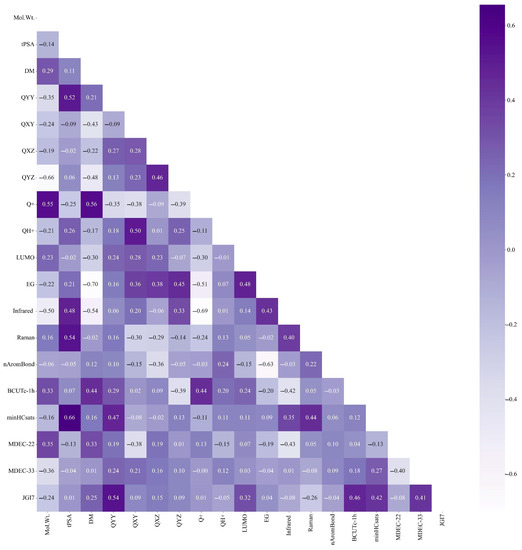
Figure 1

Journal Menu
► ▼ Journal Menu-
- IJMS Home
- Aims & Scope
- Editorial Board
- Reviewer Board
- Topical Advisory Panel
- Instructions for Authors
- Special Issues
- Topics
- Sections & Collections
- Article Processing Charge
- Indexing & Archiving
- Most Cited & Viewed
- Journal Statistics
- Journal History
- Journal Awards
- Society Collaborations
- Conferences
- Editorial Office
Journal Browser
► ▼ Journal Browser-
arrow_forward_ios
Forthcoming issue
arrow_forward_ios Current issue - Vol. 24 (2023)
- Vol. 23 (2022)
- Vol. 22 (2021)
- Vol. 21 (2020)
- Vol. 20 (2019)
- Vol. 19 (2018)
- Vol. 18 (2017)
- Vol. 17 (2016)
- Vol. 16 (2015)
- Vol. 15 (2014)
- Vol. 14 (2013)
- Vol. 13 (2012)
- Vol. 12 (2011)
- Vol. 11 (2010)
- Vol. 10 (2009)
- Vol. 9 (2008)
- Vol. 8 (2007)
- Vol. 7 (2006)
- Vol. 6 (2005)
- Vol. 5 (2004)
- Vol. 4 (2003)
- Vol. 3 (2002)
- Vol. 2 (2001)
- Vol. 1 (2000)
Highly Accessed Articles
Latest Books
E-Mail Alert
News
Topics
Topic in
Energies, IJMS, Membranes, Separations, Water
Membrane Separation Technology Research
Topic Editors: Chenxiao Jiang, Zhe Yang, Ying MeiDeadline: 15 September 2023
Topic in
Biomolecules, Cells, CIMB, IJMS, JMP, Molecules, Proteomes
Metalloproteins and Metalloenzymes
Topic Editors: Eugene A. Permyakov, Ludmilla Morozova-RocheDeadline: 30 September 2023
Topic in
Cells, Epigenomes, Genes, IJMS, IJTM
Stem Cell Differentiation and Applications
Topic Editors: Hiroyuki Hirai, Haiyun Pei, Atsushi AsakuraDeadline: 20 October 2023
Topic in
IJMS, Materials, Nanomanufacturing, Nanomaterials, Polymers
Functional Surface Modifications of Nanostructures
Topic Editors: Karolína Šišková, Nekane GuarrotxenaDeadline: 31 October 2023

Conferences
Special Issues
Special Issue in
IJMS
Bioactive Natural Products: Isolation, Structural Elucidation and Biological Assays
Guest Editor: Antonio EvidenteDeadline: 1 September 2023
Special Issue in
IJMS
Silicon-Based Solutions for the Mitigation of Abiotic and Biotic Stresses in Plants
Guest Editor: Gea GuerrieroDeadline: 10 September 2023
Special Issue in
IJMS
Molecular Mechanisms of Synaptic Plasticity 3.0
Guest Editor: Giuseppina MartellaDeadline: 30 September 2023
Special Issue in
IJMS
Metals in Biology and Medicine
Guest Editor: Todor DudevDeadline: 15 October 2023
Topical Collections
Topical Collection in
IJMS
Feature Papers in Bioactives and Nutraceuticals
Collection Editor: Maurizio Battino
Topical Collection in
IJMS
State-of-the-Art Molecular Microbiology in Poland
Collection Editors: Alicja Wegrzyn, Satish Raina
Topical Collection in
IJMS
Computational, Structural and Spectroscopic Studies of Enzyme Mechanisms, Inhibition and Dynamics
Collection Editor: Christo Christov




